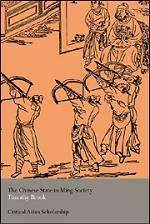Synopsis
The Chinese State in Ming Society is set in the Ming dynasty, an era in which there was much "commercial expansion and cultural innovation". [2] The book is an "account of events and issues that engaged the members of local elites in Ming society and of the interface between these elites and the state," [1] and the impact of the state on ordinary people in areas such as education, justice, the military and taxation. [1]
The book consists of a reworking of eight "heavily illustrated" essays which Brook has written and published separately over the years, and is divided into four main sections (parts I to IV) with two of these essays to each part of the book. [1] [2] The parts are named "Space", "Fields", "Books" and "Monasteries", each of which "represent important areas of intersection between the Ming state and society." [1] [2]
Brook argues that the model of despotic government fails to account for the complex interactions between individuals, groups, communities, society and state in this period. [1] Instead he proposes that by 1500 the Chinese had a remarkably developed system of governance, surpassing that of the European monarchs of the time, and that the developments were not the result of the isolated actions of the state, but rather of a complex interface and interaction, including local representatives of the state such as magistrates and local networks of the elite class of gentry. [1] According to Ellen Soulliere in her review, Brook argues that "society had the [enduring] ability to constrain, limit and sometimes redirect the authority of the state, without challenging its most basic claim to be the source of all legitimate authority." [1]
This page is based on this
Wikipedia article Text is available under the
CC BY-SA 4.0 license; additional terms may apply.
Images, videos and audio are available under their respective licenses.
